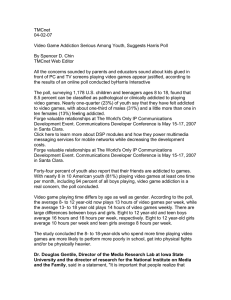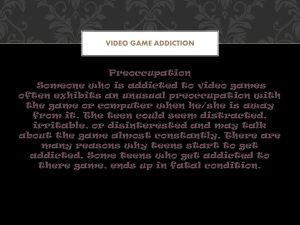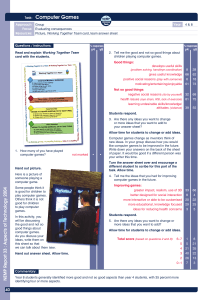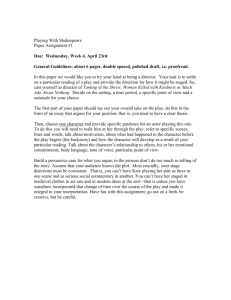Gameinfowire.com 04-03-07 Vdeo Game Addiction: Is it Real? - Survey
advertisement
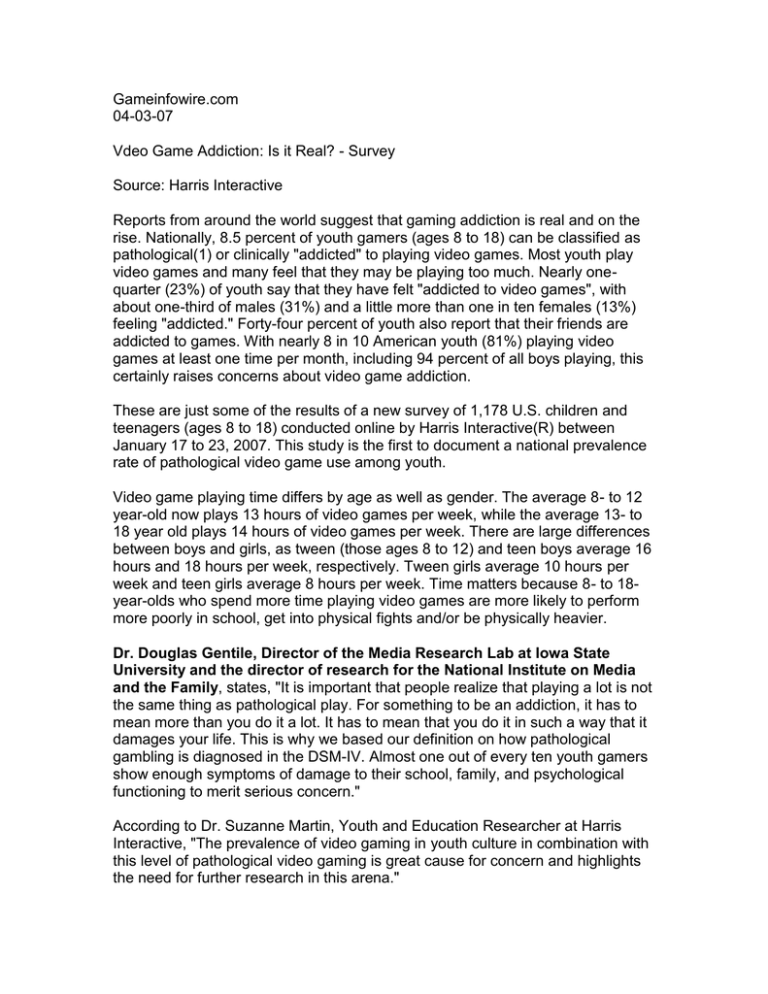
Gameinfowire.com 04-03-07 Vdeo Game Addiction: Is it Real? - Survey Source: Harris Interactive Reports from around the world suggest that gaming addiction is real and on the rise. Nationally, 8.5 percent of youth gamers (ages 8 to 18) can be classified as pathological(1) or clinically "addicted" to playing video games. Most youth play video games and many feel that they may be playing too much. Nearly onequarter (23%) of youth say that they have felt "addicted to video games", with about one-third of males (31%) and a little more than one in ten females (13%) feeling "addicted." Forty-four percent of youth also report that their friends are addicted to games. With nearly 8 in 10 American youth (81%) playing video games at least one time per month, including 94 percent of all boys playing, this certainly raises concerns about video game addiction. These are just some of the results of a new survey of 1,178 U.S. children and teenagers (ages 8 to 18) conducted online by Harris Interactive(R) between January 17 to 23, 2007. This study is the first to document a national prevalence rate of pathological video game use among youth. Video game playing time differs by age as well as gender. The average 8- to 12 year-old now plays 13 hours of video games per week, while the average 13- to 18 year old plays 14 hours of video games per week. There are large differences between boys and girls, as tween (those ages 8 to 12) and teen boys average 16 hours and 18 hours per week, respectively. Tween girls average 10 hours per week and teen girls average 8 hours per week. Time matters because 8- to 18year-olds who spend more time playing video games are more likely to perform more poorly in school, get into physical fights and/or be physically heavier. Dr. Douglas Gentile, Director of the Media Research Lab at Iowa State University and the director of research for the National Institute on Media and the Family, states, "It is important that people realize that playing a lot is not the same thing as pathological play. For something to be an addiction, it has to mean more than you do it a lot. It has to mean that you do it in such a way that it damages your life. This is why we based our definition on how pathological gambling is diagnosed in the DSM-IV. Almost one out of every ten youth gamers show enough symptoms of damage to their school, family, and psychological functioning to merit serious concern." According to Dr. Suzanne Martin, Youth and Education Researcher at Harris Interactive, "The prevalence of video gaming in youth culture in combination with this level of pathological video gaming is great cause for concern and highlights the need for further research in this arena." Gamers who were surveyed and classified as pathological were receiving lower grades in schools than their peers, were more likely to have video game systems in their bedrooms (65%), were spending much more time playing games each week (averaging 24.5 hours per week), and were also more likely to have been diagnosed with an attention deficit problem. Methodology This survey was designed in collaboration with Psychology professor Douglas Gentile, Ph.D., director of the Media Research Lab at Iowa State University and the director of research for the National Institute on Media and the Family, and was conducted online by Harris Interactive among 1,178 children and teenagers (including 497 tweens ages 8 to 12, and 681 teens ages 13 to 18) within the United States between January 17 to 23, 2007. Some questions were asked to a subset of the total sample. Figures for age, sex, race/ethnicity, education, parental education, and region were weighted where necessary to bring them into line with their actual proportions in the population. All surveys are subject to several sources of error. These include: sampling error (because only a sample of a population is interviewed); measurement error due to question wording and/or question order, deliberately or unintentionally inaccurate responses, nonresponse (including refusals), interviewer effects (when live interviewers are used) and weighting. With one exception (sampling error) the magnitude of the errors that result cannot be estimated. There is, therefore, no way to calculate a finite "margin of error" for any survey and the use of these words should be avoided. With pure probability samples, with 100 percent response rates, it is possible to calculate the probability that the sampling error (but not other sources of error) is not greater than some number. With a pure probability sample of 1,178, one could say with a ninety-five percent probability that the overall results have a sampling error of +/-3 percentage points. Sampling error for data based on subsamples may be higher and may vary. However this does not take other sources of error into account. This online survey is not based on a probability sample and therefore no theoretical sampling error can be calculated. These statements conform to the principles of disclosure of the National Council on Public Polls. About the Harris Interactive Youth and Education Research Practice The Youth and Education Research Practice conducts research among children, teens, parents, educators, administrators and policy makers that assists in understanding the lives of children, teens and college students. The team specializes in research related to marketing geared toward the young consumer, to public policy related to youth and education, to family and parenting issues, and satisfaction studies and research that measures the standards of K-12 and higher education in districts across the nation. The practice conducts custom and syndicated studies both for non-profit and for- profit organizations.
